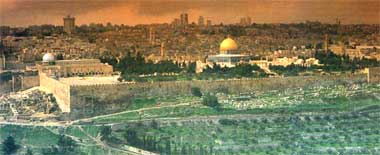Editor, H. S. (2002;2002). BAR 13:03 (May/June 1987). Biblical Archaeology Society.
King Solomon's Wall Still Supports the Temple Mount
By Ernest-Marie Laperrousaz

Richard Nowitz
Where Solomon's Temple stood in Jerusalem. Somewhere near the place where the golden Dome of the Rock mosque now stands, Solomon built the First Temple. Along the steep slope, covered here in spring green, Solomon constructed a retaining wall and then piled earth behind it to support the eastern side of the rectangular platform on which the Temple stood. Solomon's Temple was destroyed in 587 B.C. by the Babylonians. But did Nebuchadnezzar's forces also demolish the wall along the eastern valley? At the base of this wall, 107 feet from the southeast corner of the Temple Mount, is a clear joining of two kinds of stones. To the left of the joint is the extension of the eastern wall built by Herod the Great in the first century B.C., when he Увеличитьd the platform and rebuilt the Second Temple, originally constructed by the resuming exiles. To the right of the joint are distinctly different stones which the author says are likely to be some of the very stones that Solomon first placed there in the tenth century B.C.
"No actual remains of Solomonic Jerusalem have survived," Dr. Kathleen Kenyon wrote shortly before her death in 1978.1 Most scholars would agree with famous British archaeologist even today.
I believe she is wrong. A major Solomonic monument is visible in Jerusalem today for all to see. Indeed, virtually every visitor to Jerusalem does see it, but, like the scholars, fails to recognize it for what it is.
I believe part of the eastern wall of the Temple Mount is Solomonic construction.
All agree that in about 960 B.C. Solomon started to build his famous temple somewhere on the Temple Mount (see 1 Kings 5–7 ; 2 Chronicles 2–4 ), although there is considerable debate about just where it was located within this monumental enclosure.2 Nor is there any doubt that Solomon built a temple enclosure wall and filled it in to create a level surface or podium on which to build not only the Temple of Yahweh, but also his own palace.
1Kathleen Kenyon, The Bible and Recent Archaeology (London: British Museum Publications, 1978), p. 52. See also Kenyon, Royal Cities of the Old Testament (Covent Garden: Berrie and Jenkins, 1971), p. 46: "Not a trace has survived of Solomon's Jerusalem."
2Asher S. Kaufman, "Where the Ancient Temple of Jerusaiem Stood," BAR 09:02.
next page >
page 1:13
 
|
Biblical Archaeology Review
This article is part of the Biblical Archaeology Review Archive CD-ROM. Click here to learn more.
|
|